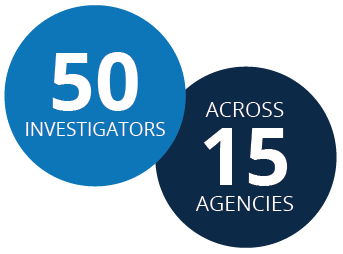Using Data Intelligence to Fight Pandemic Fraud
We're changing the way watchdogs use analytics to root out fraud, waste, abuse, and mismanagement—and work together to hold criminals accountable.
We have a big job: overseeing $5 trillion in pandemic relief.
The pandemic upended our lives seemingly overnight, putting health, jobs, and our way of life at risk. The government’s response was swift and dramatic. Congress enacted several key pandemic relief measures—including the $2.1 trillion CARES Act and the $1.9 trillion American Rescue Plan Act—to stabilize the economy and keep Americans afloat.
But while the government worked to stem the crisis, criminals exploited it, conducting pandemic-related schemes behind their screens and skimming from pandemic relief money intended to prop up businesses, communities, and ordinary people.
To help us succeed in our mission—supporting partner watchdogs oversee this massive amount of money and hold wrongdoers accountable—we established two initiatives: the Pandemic Analytics Center of Excellence (PACE) and the PRAC Fraud Task Force.
These initiatives have changed the way we work, allowing us to conduct oversight and collaborate in ways the oversight community has never done before. Here’s how they work together to transform data into evidence that investigators use to stop fraud in its tracks.

Overseeing this kind of funding requires data. Lots of data.
Our data scientists are sorting through more than 150,000,000 lines of data in both public and non-public federal spending data sets. You can explore some of these public federal data sets yourself.
For the sets that are not shared with the public—such as for small business relief programs like the Paycheck Protection Program—we share with our 36 law enforcement partners, granting access to information they wouldn’t be able to access otherwise.
It’s a collaborative effort that delivers analytic, audit, and investigative support across the oversight community.
This level of oversight also requires people who love data.
The PACE is made up of a talented team of data scientists with a range of experience across the government, private sector, and academia, whose skills are in high demand. These professionals share a commitment to serving the American public by building an affordable, flexible, and scalable analytics platform and rooting out historic levels of fraud, waste, and abuse in pandemic relief programs.
Through our Data Science Fellows program, we also funnel a pipeline of technical talent into the oversight community, hiring Fellows and embedding them with partner watchdogs. The Data Science Fellows we’ve placed so far are looking at how transportation-related funding was spent. They’re also supporting unemployment insurance fraud investigations and examining issues related to health care. Through this strategy, we’re creating a legacy to support watchdogs during this current crisis and in future ones.
“The PRAC’s long-term strategy for its Data Analytics Center of Excellence is sustainment. We want to ensure that this high level of collaboration and expertise becomes a fixture when conducting oversight for years to come.”
- Michael E. Horowitz, PRAC Chair
What do our data scientists look for exactly?
They look for trends, patterns, and anomalies—for example, clusters of loan applications with similar characteristics (like the same location, IP address, or dollar amount).
Our data scientists also use social media analysis to draw connections. Since today’s fraudsters use social media just like the rest of us do, unanticipated linkages online can lead to uncovering fraud rings in real life.
They take indicators like these—that is, signals that money may not have been used for its intended purpose—and through machine learning, teach computers to recognize fraud when they “see” it.

“Watchdogs stand a better chance of identifying fraud by combining data sets and using tools like link analysis and anomaly detection. They stand an even greater chance of catching fraudsters and holding them accountable by sharing informed data insights across the oversight community, among state and local partners, and with investigators in the field.”
- Robert A. Westbrooks, Executive Director, PRAC
We use risk models, machine learning, and Artificial Intelligence (AI) to drive efficiency
Exploring this vast amount of data is a huge task for humans. That’s why our data scientists use AI to develop robotic processes for automating some of the tasks associated with monitoring pandemic relief spending.
This saves our federal, state, and local partners critical time and helps recipients that report spending information.
We’ve also developed risk models to identify high-risk recipients of pandemic funds. For instance, through our data sharing working group of Inspectors General, we’ve disseminated reusable code that searches multiple data sources to find cases in which a person or company dipped into pandemic relief money from multiple programs. This code can help watchdogs root out issues like identity theft, multi-dipping When a recipient receives money from multiple federal sources and uses it for the same purpose, this could be an indication of multi-dipping. , and Paycheck Protection Program fraud.
Through these risk models, we’re helping oversight professionals prioritize audits and investigations.

So, we've found a red flag. Now what?
After our data scientists collect, mine, and analyze data for potential fraud, the PRAC Fraud Task Force takes over.
We started the PRAC Fraud Task Force to help law enforcement pursue investigations and criminal enforcement related to pandemic relief fraud. The Task Force does this by focusing resources where they’re needed the most while also working closely with the Department of Justice.
Experienced investigators across the watchdog community volunteer to join the Task Force. We provide additional training, specific to investigating pandemic relief fraud cases.
It all comes down to accountability, through data-driven investigations.
Fraudsters might think they’ve gotten away with some of the schemes we’ve seen during the pandemic. But the current federal statute of limitations (that is, the amount of time the government has to file charges) for pandemic-related fraud ranges from 5 to 10 years.
“So far, we’ve seen a range of fraud schemes. We’ve had individuals and organized crime groups steal pandemic relief funds and use them for things like luxury cars, jewelry, and cryptocurrency 'investments.' And that’s just the tip of the iceberg, given the scope of potential fraud.”
- Chris Covington, Manager of the Fraud Task Force, PRAC
Bottom line: We’re fighting fraud with every resource we have.
The money provided through pandemic relief programs was meant to help you, someone you know, or a business near you that really needed the support. The details of where that money went can be found in the data. The American public is also a critical partner in helping watchdogs sniff out fraud. Should you come across any red flags involving pandemic relief funds in your community, let us know by submitting a hotline complaint. Help us ensure pandemic relief money got to the people who needed it when they needed it the most.

